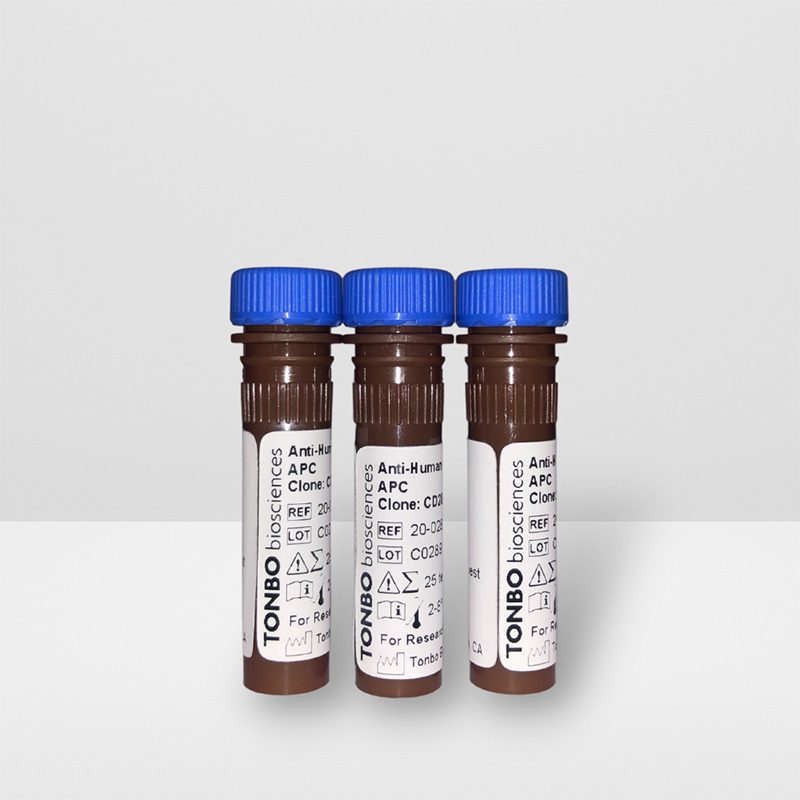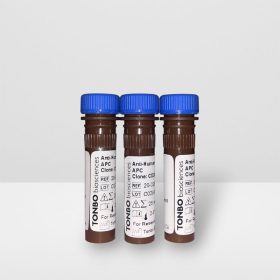The BNI3 antibody is specific for human CD152, commonly known as CTLA-4, a 33-37 kDa protein expressed as a homodimer on the surface of activated T and B cells, and on thymocytes. CTLA-4 is structurally similar, yet functionally disparate, to the T cell co-stimulatory molecule CD28. Both CTLA-4 and CD28 interact with the co-stimulatory molecules CD80 (B7-1) and CD86 (B7-2) on antigen-presenting cells, with CTLA-4 displaying a higher avidity than CD28. While CD28 typically delivers a potent co-stimulatory signal in support of T cell activation, CTLA-4 appears to act as a negative regulator of T cell activation and may contribute to the suppressor function of Treg cells.
CTLA-4 proteins may be initially sequestered within Golgi vesicles, from which they can be transferred to and from the cell surface, a mechanism by which Treg cells can selectively impart suppressive functions. The BNI3 antibody may be used for flow cytometric analysis of intracellular or surface CTLA-4 expression, and is also widely used for neutralization of CTLA-4 when expressed at the cell surface. The BNI3 antibody is reported to be cross-reactive with Baboon, Cynomolgus and Rhesus CTLA-4. Please choose the appropriate format for each application.
Product Details
| Name | In Vivo Ready™ Anti-Human CD152 (CTLA-4) (BNI3) |
|---|---|
| Cat. No. | 40-1529 |
| Alternative Names | CTLA4 |
| Gene ID | 1493 |
| Clone | BNI3 |
| Isotype | Mouse IgG2a, κ |
| Reactivity | Human |
| Cross Reactivity | Baboon, Cynomolgus, Rhesus |
| Format | In Vivo Ready™ |
| Application | Flow Cytometry, Functional Assays |
| Citations* | Moreno-Fernandez ME, Rueda CM, Rusie LK, and Chougnet CA. 2011. Blood. 117: 5372-5380. (in vitro blocking)
Schonfeld D, Matschiner G, Chatwell L, Trentmann S, Gille H, Hulsmeyer M, Brown N, Kaye PM, Schlehuber S, Hohlbaum AM and Skerra A. 2009. 106: 8198-8203. (Immunohistochemistry – frozen tissue) Rivas MN, Weatherly K, Hazzan M, Vokaer B, Dremier S, Gaudray F, Goldman M, Salmon I, and Braun MY. 2009. 183:4284-4291. (in vitro blocking) Bonzheim I, Geissinger E, Tinguely M, Roth S, Grieb T, Reimer P, Wilhelm M, Rosenwald A, Muller-Hermelink HK, and Rudiger T. 2008. Am. J. Clin. Pathol. 130: 613-619. (Immunohistochemistry – paraffin embedded tissue; Immunofluorescence microscopy – frozen tissue) Young NT, Waller ECP, Patel R, Roghanian A, Austyn JM, and Trowsdale J. 2008. 111: 3090-3096. (in vitro activation) Wei B, da Rocha Dias S, Wang H and Rudd CE. 2007. J. Immunol. 179: 400-408. (in vitro activation) Jonuleit H, Schmitt E, Stassen M, Tuettenberg A, Knop J and Enk AH. 2001. J. Exp. Med. 193: 1285-1294 (in vitro blocking) Oaks MK and Hallett KM. 2000. J. Immunol. 164: 5015-5018. (Immunoprecipitation; EIA – plate coating) |
Application Key:FC = Flow Cytometry; FA = Functional Assays; ELISA = Enzyme-Linked Immunosorbent Assay; ICC = Immunocytochemistry; IF = Immunofluorescence Microscopy; IHC = Immunohistochemistry; IHC-F = Immunohistochemistry, Frozen Tissue; IHC-P = Immunohistochemistry, Paraffin-Embedded Tissue; IP = Immunoprecipitation; WB = Western Blot; EM = Electron Microscopy
*Tonbo Biosciences tests all antibodies by flow cytometry. Citations are provided as a resource for additional applications that have not been validated by Tonbo Biosciences. Please choose the appropriate format for each application and consult the Materials and Methods section for additional details about the use of any product in these publications.









